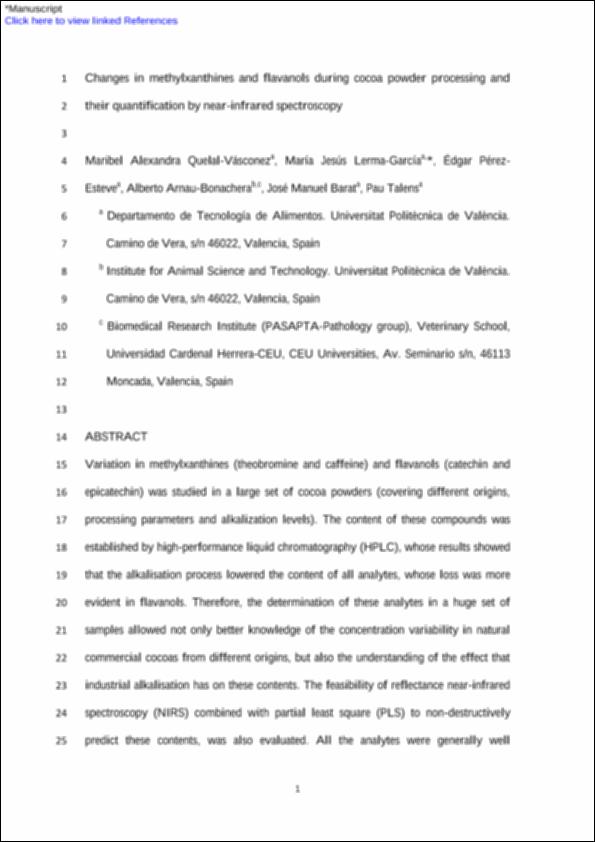Please use this identifier to cite or link to this item:
http://hdl.handle.net/10637/13434Changes in methylxanthines and flavanols during cocoa powder processing and their quantification by near-infrared spectroscopy
| Title: | Changes in methylxanthines and flavanols during cocoa powder processing and their quantification by near-infrared spectroscopy |
| Authors : | Quelal Vásconez, Maribel Alexandra Lerma García, María Jesús Pérez Esteve, Édgar Arnau Bonachera, Alberto Barat Baviera, José Manuel Talens Oliag, Pau |
| Keywords: | Food - Quality.; Alimentos - Análisis.; Alimentos - Control de calidad.; Cocoa.; Cacao.; Food - Analysis. |
| Publisher: | Elsevier |
| Citation: | Quelal-Vásconez, M.A., Lerma-García, M.J., Pérez-Esteve, É., Arnau-Bonachera, A., Barta, J.M. & Talens, P. (2020). Changes in methylxanthines and flavanols during cocoa powder processing and their quantification by near-infrared spectroscopy. LWT - Food Science and Technology, vol. 117, art. 108598 (jan.). DOI: https://doi.org/10.1016/j.lwt.2019.108598 |
| Abstract: | Variation in methylxanthines (theobromine and caffeine) and flavanols (catechin and epicatechin) was studied in a large set of cocoa powders (covering different origins, processing parameters and alkalization levels). The content of these compounds was established by high-performance liquid chromatography (HPLC), whose results showed that the alkalisation process lowered the content of all analytes, whose loss was more evident in flavanols. Therefore, the determination of these analytes in a huge set of samples allowed not only better knowledge of the concentration variability in natural commercial cocoas from different origins, but also the understanding of the effect that industrial alkalisation has on these contents. The feasibility of reflectance near-infrared spectroscopy (NIRS) combined with partial least square (PLS) to non-destructively predict these contents, was also evaluated. All the analytes were generally well predicted, with better predictions for methylxanthines (R2 P 0.882 for both analytes; RMSEP 0.020-0.061%, bias -0.027-0.006) than for flavanols (R2 P 0.818-0.863; RMSEP 6.63-15.87%, bias 1.942-3.056). Thus NIRS could be an alternative fast reliable method for the routine assessment of these analytes in the cocoa industry. |
| Description: | Este artículo se encuentra disponible en la siguiente URL: https://www.sciencedirect.com/science/article/abs/pii/S0023643819309405 This is the pre-peer reviewed version of the following article: Quelal-Vásconez, M.A., Lerma-García, M.J., Pérez-Esteve, E., Arnau-Bonachera, A., Barata, J.M. & Talens, P. Changes in methylxanthines and flavanols during cocoa powder processing and their quantification by near-infrared spectroscopy. LWT - Food Science and Technology, vol. 117, art. 108598 (jan. 2020), which has been published in final form at https://doi.org/10.1016/j.lwt.2019.108598 Este es el pre-print del siguiente artículo: Quelal-Vásconez, M.A., Lerma-García, M.J., Pérez-Esteve, E., Arnau-Bonachera, A., Barata, J.M. & Talens, P. Changes in methylxanthines and flavanols during cocoa powder processing and their quantification by near-infrared spectroscopy. LWT - Food Science and Technology, vol. 117, art. 108598 (jan. 2020), que se ha publicado de forma definitiva en https://doi.org/10.1016/j.lwt.2019.108598 |
| URI: | http://hdl.handle.net/10637/13434 |
| Rights : | http://creativecommons.org/licenses/by-nc-nd/4.0/deed.es |
| ISSN: | 0023-6438 |
| Issue Date: | 2-Jan-2020 |
| Center : | Universidad Cardenal Herrera-CEU |
| Appears in Collections: | Dpto. Producción y Sanidad Animal, Salud Pública Veterinaria y Ciencia y Tecnología de los Alimentos |
Items in DSpace are protected by copyright, with all rights reserved, unless otherwise indicated.


